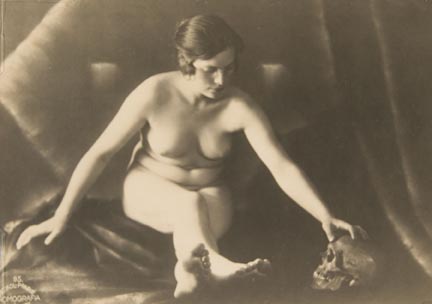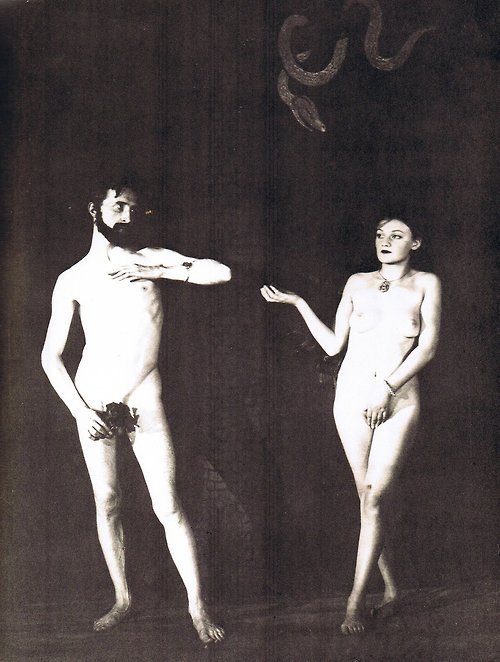Ramon Martinez
Carrying The Cross
Photograph
Private collection
My name is Ramon Martinez. I work with experimental art in video, photography, 3D art, 3D animations, etc. about the subject the crucified female Christ.
I've started my art project since early 2005 and I've named my art project "Passion Of A Goddess".
"Many artists during the past 2000 years have been interested in the picture of a crucified Jesus. One of the reasons is probably that this subject offers a lot of symbolic value as well as possibilities to manifest different expressions. Although the question raised is why these artefacts are always male? In a few cases, Jesus portraitures as a female raise negative consequences from the conservative parts of the church. The idea that God can only be a man is an idea created in a society with male dominance. I would like to develop the idea that giving God a sex is not honest. These believers of the idea that God can only be represented as a man disregard the female half of the world´s population. And also its in my belief that a woman has greater ability to give love than a man. Christ represents the great love."
My art project tries also, to fight religious intransigence that tries to coerce the freedom of expression and individual freedoms recognized in The Universal Declaration of Human Rights. More on Ramon Martinez
Ramon Martinez
Female Jesus
Private collection
Ramon Martinez
Dark Portrait Of A Female Jesus II
Private collection
Dark portrait of Jesus as woman. This image has been selected as cover of the German thriller "Fn" by Gregor Eisenhauer
Ramon Martinez
Carrying The Cross II
Photograph
Private collection
Ramon Martinez
Carrying The Cross III
Photograph
Private collection
Ramon Martinez
Carrying The Cross V
Photograph
Private collection
Ramon Martinez
Crucified woman in sepia
Photograph
Private collection
Ramon Martinez
Suffering in light
Photograph
Private collection
Ramon Martinez
Experimental woman on cross
Photograph
Private collection
Frantisek Drtikol (1883-1961)
Salome, c. 1919
Pigment print
8 x 10 3/8in. (20.2 x 26.2cm.)
Private collection
František Drtikol (3 March 1883, Příbram – 13 January 1961, Prague) was a Czech photographer of international renown. He is especially known for his characteristically epic photographs, often nudes and portraits. From 1907 to 1910 he had his own studio, until 1935 he operated an important portrait photostudio in Prague. Drtikol made many portraits of very important people and nudes which show development from pictorialism and symbolism to modern composite pictures of the nude body with geometric decorations and thrown shadows, where it is possible to find a number of parallels with the avant-garde works of the period. These are reminiscent of Cubism, and at the same time his nudes suggest the kind of movement that was characteristic of the futurism aesthetic.
Frantisek Drtikol (1883-1961)
Ervina Kupferova as Salome with the head of John the Baptist
Photograph
22 x 19.5 cm. (8.7 x 7.7 in.)
Private collection
FRANTIŠEK DRTIKOL (1883–1961)
Salome and ?ena a maska, 1924
gelatin silver prints
4 5/8 x 3 1/2 in. (11.8 x 9 cm.)
Private collection
He began using paper cut-outs in a period he called "photopurism". These photographs resembled silhouettes of the human form. Later he gave up photography and concentrated on painting. After the studio was sold Drtikol focused mainly on painting, Buddhist religious and philosophical systems. In the final stage of his photographic work Drtikol created compositions of little carved figures, with elongated shapes, symbolically expressing various themes from Buddhism. In the 1920s and 1930s, he received significant awards at international photo salons. More on František Drtikol
FRANTIŠEK DRTIKOL (1883–1961)
Salome, c. 1924
gelatin silver prints
carte-postale
8.27 X 11.54 in (21 X 29.3 cm)
Private collection
Drtikol, František
Untitled #33, (smiling nude with skull to her right [Salome])
Bromide print
image: 4 1/8 in x 5 1/16 in; mat: 16 in x 14 1/8 in; paper: 4 1/2 in x 6 5/16 in
MUSEUM OF CONTEMPORARY PHOTOGRAPHY AT COLUMBIA COLLEGE CHICAGO
Drtikol, František
Untitled #95 (nude with skull to her left [Salome]
Bromide print
image: 4 1/8 in x 5 1/2 in; mat: 16 1/8 in x 14 in; paper: 4 1/2 in x 6 3/8 in
MUSEUM OF CONTEMPORARY PHOTOGRAPHY AT COLUMBIA COLLEGE CHICAGO
Drtikol, František
Salomé (c. 1920).
Bromide print
9 1/4 in x 5 7/8 in; paper: 11 1/2 in x 8 7/8 in
Private collection
Drtikol, František
Untitled (nude reclined on ledge, crucifix hill background)
Bromide print
9 1/4 in x 5 7/8 in; paper: 11 1/2 in x 8 7/8 in
MUSEUM OF CONTEMPORARY PHOTOGRAPHY AT COLUMBIA COLLEGE CHICAGO
1908 Vintage Theatre
Miss Lotta Faust
The Salome Dance in 'The Mimic World'
Private collection
Lotta Faust (February 8, 1880 – January 25, 1910) was an actress, dancer, and singer from Brooklyn, New York. She performed an interpretation of the Salome dance based on the Salome (play) (1893) by Oscar Wilde. More on Lotta Faust
Unknown
There is still no description of this artwork
Cindy Sherman
Untitled (Madonna), c. 1975
7 x 5 in (17.78 x 12.7 cm)
Gelatin silver print
Savannah College of Art and Designs
“In this black-and-white portrait, Sherman plays the role of the Madonna. Although she is shrouded in a white veil like a classically rendered religious figure, Sherman’s elongated eyelashes, accentuated lips and pomaded dual horn-like curls peeking out from beneath her veil play with the traditional historic depiction. Her stylized image could be a reference to the “new woman” of the 1920s whose liberated views on sexuality are in direct opposition to the virginal, biblical Madonna. Reprinted in the 1990s, the portrait may also be considered a reference to the contemporary and controversial pop singer of the same name.” More on this photograph
Cindy Sherman
Untitled (Judith?)
from the History portraits series, 1990
Chromogenic color print
6' 10 1/16" x 48" (208.4 x 122 cm)
The Museum of Modern Art
Judith looks boldly out at her audience and presents the head of Holofernes in her right hand, displaying the dagger she used to decapitate him in her left. She is garbed in billowing red, blue, and green drapery and stands in front of a curtain made of pieces of brocaded and patterned fabric. Her head is tilted slightly to her left, much like the heroines in paintings by Botticelli; she likewise stands on a carpet of green grass speckled with flowers. But unlike Botticelli’s pristine and idealized nudes, Judith’s makeup is heavy-handed, almost tacky. The fabrics that at first seem to glimmer are, upon closer inspection, chintzy and cheap. And Holofernes’ head, which is usually frightening and powerful, looks like a used Halloween mask. More on this work
Cynthia Morris Sherman (born 1954) is an American artist whose work consists primarily of photographic self-portraits, depicting herself in many different contexts and as various imagined characters.
Her breakthrough work is often considered to be the collected Untitled Film Stills, a series of 70 black-and-white photographs of herself evoking typical female roles in performance media (especially arthouse films and popular B-movies). In the 1980s, she used color film and large prints, and focused more on costume, lighting and facial expression. More on Cynthia Morris Sherman
Bocharov Sergey Petrovich
Eve, c. 1983
I have no further description, at this time
Bocharov Sergey Petrovich was born in Siberia. He graduated from the Krasnodar art school, the Studio of Nadia léger in Paris, the Russian Academy of arts in St. Petersburg, and the all-Union state Institute of cinematography (VGIK) in Moscow.
He works in genres of portrait, landscape, still life and others. A special place in the works of Sergei Bocharov is easel painting in the genre of group portrait, which expresses the theme of contemporary Russia.
His paintings are in the collections of Russian and foreign museums, private galleries and collections in Germany, Norway, Japan, Korea, France, USA, Italy.
The winner of the Grand Prix in France and in Italy. Italian prize - competition view of Venice, which is arranged for all artists of the world every 5 years. The last winner from Russia, to S. P. Bocharova, was 140 years ago Aivazovsky. As the winner of the contest, S. P. Bocharov had the right to sell a painting to the Museum of Italy for 50 thousand dollars. The artist brought her to Russia in the hope that someday she will be in the Russian Museum.
Overcoming difficulties, the Artist realizes every opportunity to show my paintings to the nation. His exhibitions were held in overcrowded halls in Moscow, Vladimir, Ryazan, Lipetsk, Rostov-on-don, Zernograd, Nizhny Novgorod, Arzamas. Lives and works in Moscow.
More on Bocharov Sergey Petrovich
Man Ray (American, 1890–1976)
Adam and Eve (Marcel Duchamp and Bronia Perlmutter), c. 1924
Gelatin silver print

























No comments:
Post a Comment